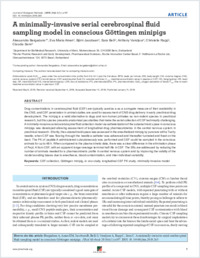A minimally-invasive serial cerebrospinal fluid sampling model in conscious Göttingen minipigs.
- Bergadano A Department for BioMedical Research, University of Bern, Murtenstrasse 35, CH-3008 Bern, Switzerland.
- Amen EM Roche Pharma Research and Early Development, Pharmaceutical Sciences, Roche Innovation Center Basel, F. Hoffmann-La Roche Ltd, Grenzacherstrasse 124, 4070 Basel, Switzerland.
- Jacobsen B Roche Pharma Research and Early Development, Pharmaceutical Sciences, Roche Innovation Center Basel, F. Hoffmann-La Roche Ltd, Grenzacherstrasse 124, 4070 Basel, Switzerland.
- Belli S Roche Pharma Research and Early Development, Pharmaceutical Sciences, Roche Innovation Center Basel, F. Hoffmann-La Roche Ltd, Grenzacherstrasse 124, 4070 Basel, Switzerland.
- Vandjour A Roche Pharma Research and Early Development, Pharmaceutical Sciences, Roche Innovation Center Basel, F. Hoffmann-La Roche Ltd, Grenzacherstrasse 124, 4070 Basel, Switzerland.
- Rapp C Roche Pharma Research and Early Development, Pharmaceutical Sciences, Roche Innovation Center Basel, F. Hoffmann-La Roche Ltd, Grenzacherstrasse 124, 4070 Basel, Switzerland.
- Senn C Roche Pharma Research and Early Development, Pharmaceutical Sciences, Roche Innovation Center Basel, F. Hoffmann-La Roche Ltd, Grenzacherstrasse 124, 4070 Basel, Switzerland.
- 2019-08-28
Published in:
- Journal of biological methods. - 2019
English
Drug concentrations in cerebrospinal fluid (CSF) are typically used as a as a surrogate measure of their availability in the CNS, and CSF penetration in animal studies are used for assessment of CNS drug delivery in early preclinical drug development. The minipig is a valid alternative to dogs and non-human primates as non-rodent species in preclinical research, but this species presents anatomical peculiarities that make the serial collection of CSF technically challenging. A minimally-invasive serial cerebrospinal fluid collection model via catheterization of the subarachnoid space in conscious minipigs was developed allowing assessment of longitudinal drug pharmacokinetics in the central nervous system in preclinical research. Shortly, the subarachnoid space was accessed in the anesthetized minipig by puncture with a Tuohy needle; when CSF was flowing through the needle a catheter was advanced and thereafter tunneled and fixed on the back. The PK of peptide A administered subcutaneously was performed and CSF could be sampled in the conscious animals for up to 48 h. When compared to the plasma kinetic data, there was a clear difference in the elimination phase of Pept. A from CSF, with an apparent longer average terminal half-life in CSF. The 3Rs are addressed by reducing the number of animals needed for a pharmacokinetic profile in central nervous system and by improving the validity of the model avoiding biases due to anesthesia, blood contamination, and inter-individual variability.
- Language
-
- English
- Open access status
- gold
- Identifiers
-
- DOI 10.14440/jbm.2019.265
- PMID 31453257
- Persistent URL
- https://sonar.ch/global/documents/192654
Statistics
Document views: 73
File downloads:
- Full-text: 0
